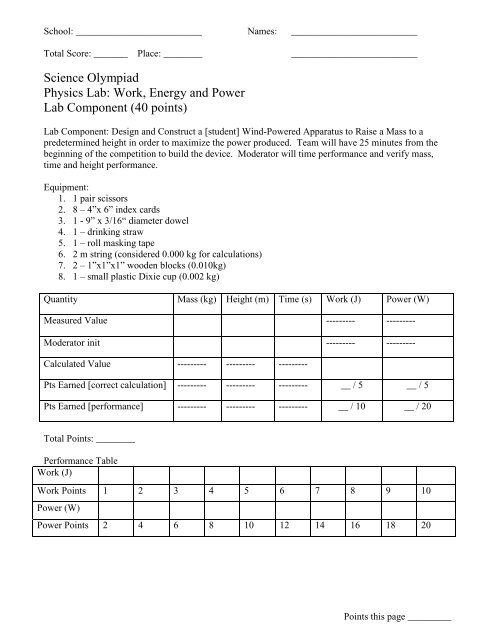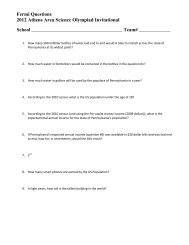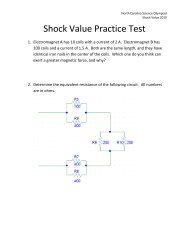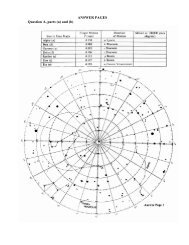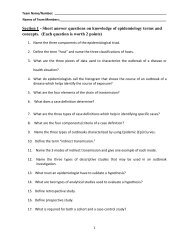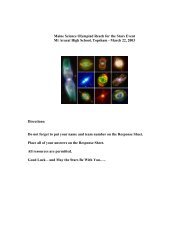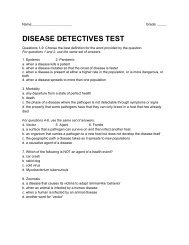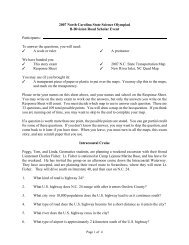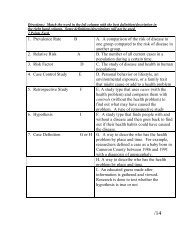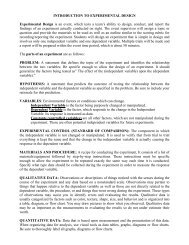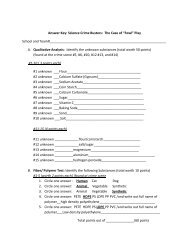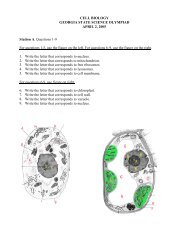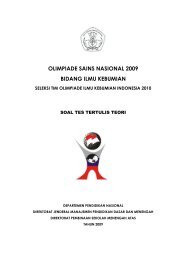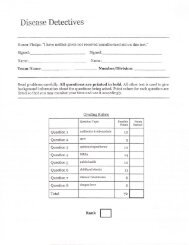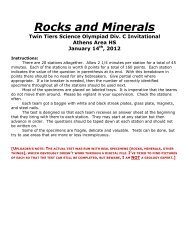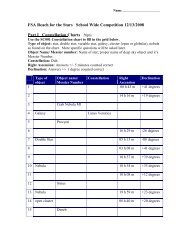Science Olympiad Physics Lab: Work, Energy and Power Lab ...
Science Olympiad Physics Lab: Work, Energy and Power Lab ...
Science Olympiad Physics Lab: Work, Energy and Power Lab ...
You also want an ePaper? Increase the reach of your titles
YUMPU automatically turns print PDFs into web optimized ePapers that Google loves.
School: __________________________ Names: __________________________<br />
Total Score: _______ Place: ________<br />
__________________________<br />
<strong>Science</strong> <strong>Olympiad</strong><br />
<strong>Physics</strong> <strong>Lab</strong>: <strong>Work</strong>, <strong>Energy</strong> <strong>and</strong> <strong>Power</strong><br />
<strong>Lab</strong> Component (40 points)<br />
<strong>Lab</strong> Component: Design <strong>and</strong> Construct a [student] Wind-<strong>Power</strong>ed Apparatus to Raise a Mass to a<br />
predetermined height in order to maximize the power produced. Team will have 25 minutes from the<br />
beginning of the competition to build the device. Moderator will time performance <strong>and</strong> verify mass,<br />
time <strong>and</strong> height performance.<br />
Equipment:<br />
1. 1 pair scissors<br />
2. 8 – 4”x 6” index cards<br />
3. 1 - 9” x 3/16“ diameter dowel<br />
4. 1 – drinking straw<br />
5. 1 – roll masking tape<br />
6. 2 m string (considered 0.000 kg for calculations)<br />
7. 2 – 1”x1”x1” wooden blocks (0.010kg)<br />
8. 1 – small plastic Dixie cup (0.002 kg)<br />
Quantity Mass (kg) Height (m) Time (s) <strong>Work</strong> (J) <strong>Power</strong> (W)<br />
Measured Value --------- ---------<br />
Moderator init --------- ---------<br />
Calculated Value --------- --------- ---------<br />
Pts Earned [correct calculation] --------- --------- --------- __ / 5 __ / 5<br />
Pts Earned [performance] --------- --------- --------- __ / 10 __ / 20<br />
Total Points: ________<br />
Performance Table<br />
<strong>Work</strong> (J)<br />
<strong>Work</strong> Points 1 2 3 4 5 6 7 8 9 10<br />
<strong>Power</strong> (W)<br />
<strong>Power</strong> Points 2 4 6 8 10 12 14 16 18 20<br />
Points this page _________
School: __________________________ Names: __________________________<br />
<strong>Science</strong> <strong>Olympiad</strong><br />
<strong>Physics</strong> <strong>Lab</strong>: <strong>Work</strong>, <strong>Energy</strong> <strong>and</strong> <strong>Power</strong><br />
Knowledge Component (@ 3 pts / question = 60 points )<br />
__________________________<br />
1. A power plant produces 500 MW of power. How much energy is produced in one second?________J<br />
2. A power plant operates in four stages. The efficiency in the successive stages are: 80%, 40%, 12%<br />
<strong>and</strong> 65%. What is the overall efficiency of the power plant?<br />
________%<br />
3. A coal power plant with 30% efficiency burns 10 million kilograms of coal a day. (Take the heat of<br />
combustion of coal to be 30 MJ / kg.)<br />
a) What is the power output of the plant? ________W<br />
b) At what rate is thermal energy being discarded by the plant? ________W<br />
4. Sunlight of intensity 700 W / m 2 is captured with 70% efficiency by a solar panel, which then sends<br />
the captured energy into a house with 50% efficiency. If the house loses thermal energy through poor<br />
insulation at a rate of 3.0 kW, find the area of the solar panel needed in order to keep the temperature of<br />
the house constant.<br />
________m 2<br />
5. A solar heater is to warm 150 kg of water by 30K. The intensity of solar radiation is 6000 W / m 2 <strong>and</strong><br />
the area of the panels is 4.0 m 2 . The specific heat capacity of the water is 4.2 x 10 3 J / kg K. Estimate<br />
the time this will take, assuming a solar panel efficiency of 60%.<br />
________sec<br />
Points this page _________
6. The above graph shows the variation with incident solar power P of the temperature of a solar<br />
panel used to heat water when thermal energy is extracted from the water at a rate of 320 W.<br />
The area of the panel is 2.0 m 2 <strong>and</strong> the intensity of the solar radiation incident on the panel is 400<br />
W / m 2 . Calculate:<br />
a. The power incident on the panel ________W<br />
b. The efficiency of the panel ________%<br />
c. The temperature of the water ________K<br />
7. The above graph shows the power curve of a wind turbine as a function of the wind speed. If the<br />
wind speed is 10 m/s, calculate the energy produced in the course of one year assuming that the<br />
wind blows at this speed for 1000 hours in the year.<br />
________J<br />
8. The formula for wind power as a function of the air density, cross sectional area of the wind<br />
turbine blades <strong>and</strong> the wind velocity is given by<br />
1 P Av 2<br />
State the expected increase in the power extracted from the wind turbine when<br />
a. the length of the blades is doubled: ________<br />
b. the wind speed is doubled: ________<br />
c. both the length of the blades <strong>and</strong> the wind speed are doubled:<br />
________<br />
d. State one reason why the actual increase in the extracted power will<br />
be less than your answers above<br />
_________________________<br />
3<br />
Points this page _________
9. Air density 1.2 kg / m 3 <strong>and</strong> speed 8.0 m/s is incident on the blades of a wind turbine. The radius<br />
of the blades is 1.5 m. Immediately after passing through the blades, the wind speed is reduced<br />
to 3.0 m / s <strong>and</strong> the density of the air is 1.8 kg m 3 . Calculate the power extracted from the wind.<br />
________W<br />
10. Find the power developed when water in a waterfall with a flow rate of 500 L / s falls from a<br />
height of 40m.<br />
________W<br />
11. A force of 4.0 N is required to stretch a spring 0.2 m. The spring obeys Hooke’s law. Find the<br />
energy stored in the spring when it is stretched to 0.8m.<br />
________J<br />
12. The potential difference between the Earth <strong>and</strong> the bottom of a thundercloud is 35 million Volts.<br />
The bottom of a line thunder clouds is 1500 m above the earth <strong>and</strong> the area of the cloud bottoms<br />
is 110 km 2 . Modeling this Earth-cloud system as a huge capacitor, calculate:<br />
a. The capacitance of the Earth-cloud system. 0 =8.85e-12 C 2 /Nm 2 ________F<br />
b. The charge stored in the “capacitor” ________C<br />
c. The energy stored in the “capacitor” ________J<br />
Points this page _________


